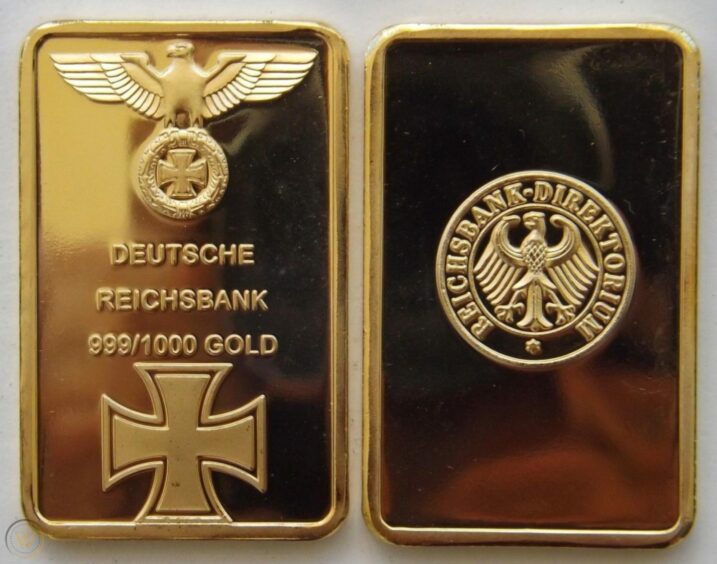
Every day, art lovers make the pilgrimage to Madrid’s Prado Museum to wonder at the masterpieces of Diego Velazquez or Francisco de Goya. Few realise, however, 100ft beneath the pavements of the Spanish capital lies more hidden and far more contentious treasure.
Thirty-eight gold ingots marked with the eagle of Nazi Germany are held in the gold chamber of the Bank of Spain, a short distance from the Prado. There is a series of doors to the chamber, each 10ft thick. The vaults will flood if thieves should break in as sensors note any change in weight. Cameras were forbidden when Spain’s national bank used to invite groups of selected visitors to gaze upon the ingots.
The media visits might now be banned but there is a new spotlight on the subterranean hoard of gold as campaigners escalate demands for ingots to be sold off to commemorate Spaniards who died in Nazi concentration camps.
Across Europe, gold looted by Nazi Germany was said to have been deposited in bank vaults from Switzerland to Portugal and the Vatican, though it took decades of negotiations to return a fraction of it to its original owners.
No thieves have so far penetrated the Bank of Spain’s underground fortress but this has not stopped screenwriters dreaming up fictional robbers smart enough to outwit the bank’s elaborate security system.
From Money Heist, the hugely successful Spanish crime series produced by Netflix, to the team behind the 2021 film The Vault, starring Freddie Highmore and Astrid Bergès-Frisbey, the idea of stealing the gold has been irresistible.
The ingots that are held in the vaults of the Bank of Spain were the result of a war-time trade in which Hitler’s Germany paid Spain for valuable wolfram ore, which was essential for its armaments industry.
After the war, Spain returned some of the gold it was paid by Germany under the orders of a commission set up by the Allies.
Spain was allowed to keep a fraction of this gold after the Allies were satisfied none of it had been looted by the Nazis from occupied nations. In the wake of General Francisco Franco’s victory in the 1936-39 civil war, thousands of Republicans fled across the border into France.
The Association for the Recuperation of the Historical Memory (ARMH), which supports families whose loved ones were murdered during the Spanish Civil War or during Franco’s long dictatorship, claims nearly 5,000 Republicans died in German concentration camps.
“We want to convert these ingots into money and with that we can create memorials (to those who were deported to concentration camps),” Emilio Silva, ARMH president, told The Sunday Post.
Since coming to power in 2019, Spain’s coalition government has made it a priority to address the open wounds of the dictatorship.
Unlike Germany, Italy or Argentina, Spain had until now never dealt with events during this dark period of its history. Instead, it passed an amnesty law in 1977 that forbade retrospective prosecutions relating to the dictatorship. In 2019, Spain’s socialist government removed the remains of General Franco from an imposing mausoleum outside Madrid, claiming commemorating the dictator in this way shamed Spain.
The government has also introduced a Democratic Memory law that will mean schoolchildren are taught about the dictatorship, and relatives of those who were murdered by Franco will receive state help to recover an estimated 114,000 bodies from mass graves across the country.
Street signs and monuments connected with El Caudillo, as the dictator was known, will also be torn down under the terms of the law.
The Bank of Spain declined to comment on the controversial gold but Pablo Martín Aceña, an expert in economic history at the University of Alcala and author of The Movements Of Spanish Gold During The Second World War, said ingots that remained in the Bank of Spain were not looted from any European country but came from the German treasury.
“There is no suggestion that these ingots were looted. Spain needed the gold because during the civil war the Republicans removed much of the gold to Russia to stop it being seized by Franco. It never returned,” he told The Sunday Post.
A 1997 US government report into Allied efforts to recover Nazi gold across Europe said Switzerland had received an estimated $400 million in gold from Germany throughout the Second World War but did not start to repay some of this looted gold until 1962.
During the war, neutral nations such as Spain and Switzerland continued to trade with Nazi Germany and after the war disputed they possessed looted gold or that they should repay German assets to other countries.
Switzerland was highlighted as the worst nation for its resistance to paying back looted gold.
“Over the years, the inflexibility of the Swiss Bankers’ Association and other Swiss banks made it extremely difficult for surviving family members of Nazi victims to successfully file claims to secure bank records and other assets,” the 1997 US Government report said.
“This overall pattern of apparent Swiss bankers’ indifference to the needs of the victims of the Holocaust and their heirs persisted until the current international pressures came to bear and, for instance, the appointment of an Ombudsman in 1996.”
By 1945, Spain had acquired about 123 tons of gold from Germany, worth nearly $140m at post-war value. The US estimated 72% of the gold acquired by Spain – worth about $100m – had been looted by Germany from the nations it occupied.
Protracted post-war Allied negotiations with Spain over the restitution of gold led to a 1946 agreement under which Madrid said it would turn over $25m in German assets.
In 1948, Spain agreed to pay back some of the $30m in looted Dutch gold. The Allies publicly acknowledged Spain was not aware it had received looted gold.
As the Cold War got under way in earnest, the United States was keen not to isolate Spain, fearing it could lead to a second civil war or allow the Communists to gain a foothold in the Iberian peninsula.
By 1950, the Allies normalised relations with Franco’s Spain and demands for more gold to be returned were frozen.

Enjoy the convenience of having The Sunday Post delivered as a digital ePaper straight to your smartphone, tablet or computer.
Subscribe for only £5.49 a month and enjoy all the benefits of the printed paper as a digital replica.
Subscribe © SYSTEM
© SYSTEM